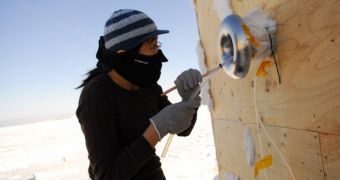Scientists with the School of Earth and Atmospheric Sciences at the Georgia Institute of Technology (Georgia Tech), in Atlanta, announce the discovery of very large amounts of molecular chlorine in the air above Barrow, Alaska. Similar levels may permeate the Arctic, researchers warn.
This chemical is released naturally during the process that sees sea ice melted. Important amounts of sea salt are released in the process, which then go on to react with sunlight to produce chlorine atoms.
At first glance, some would say that the release of chlorine is good news, since the element oxidizes methane, a potent greenhouse gas. While that may be true, chlorine also oxidizes other atmospheric constituents, such as mercury, which is then deposited throughout the Arctic ecosystem.
The investigation was conducted as part of the international OASIS initiative. The American participation was supported by the US National Science Foundation (NSF). Details of the work appear in a paper published in the January 12 issue of the top scientific journal Nature Geoscience.
Chlorine levels were measured in the spring of 2009 through a technique called chemical ionization mass spectrometry. This enabled researchers to collect extremely accurate readings on the composition of the atmosphere over Barrow, Alaska.
“No one expected there to be this level of chlorine in Barrow or in polar regions,” says Georgia Tech SEAS professor Greg Huey. He led the recent study, which was the first to measure chlorine concentrations in the Arctic with any degree of precision, PhysOrg reports.
The team established that chlorine exists in the air over Alaska in a concentration of 400 parts per trillion. This may seem very small to laypersons, but researchers know that these levels are very high. It is unusual for so much chlorine to exist freely, because it reacts readily with other atmospheric chemicals.
This suggests that a very potent source of chlorine exists in the Arctic, replenishing the atoms that go on to oxidize other elements. Interestingly, the six-week study revealed that chlorine concentrations spiked in the morning and afternoon, but leveled off to zero at night.
The team was also able to determine that chlorine levels during the day were related to the amount of available ozone, suggesting that both ozone and sunlight play a role in the formation of this chemical.
“We don't really know the mechanism. It's a mystery to us right now. But the sea ice is changing dramatically, so we're in a time where we have absolutely no predictive power over what's going to happen to this chemistry. We're really in the dark about the chlorine,” Huey explains.
“There is definite climate change happening in the Arctic. That's changing the nature of the ice, changing the volume of the ice, changing the surface area and changing the chemistry of the ice,” the expert concludes.

 14 DAY TRIAL //
14 DAY TRIAL //